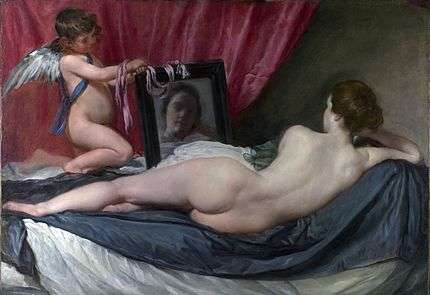Venus effect

The Venus effect is a phenomenon in the psychology of perception, named after various paintings of Venus gazing into a mirror, such as Diego Velázquez's Rokeby Venus, Titian's Venus with a Mirror, and Veronese's Venus with a mirror. Viewers of such paintings assume that Venus is admiring her own reflection in the mirror; however, since the viewer sees her eyes in the mirror, Venus is actually looking at the reflection of the painter.[1]
This psychological effect is often used in the cinema, where an actor will be shown apparently looking at himself or herself in the mirror. What viewers see is different from what the actor sees, because the camera is not right behind the actor, but the position of the actor is often chosen so that his or her image is nicely framed in the mirror for the camera.
Although the name of the effect refers to a woman, Venus, the effect is more general. The effect is seen with an animal apparently looking at itself in a mirror in The Lady and the Unicorn (French: La Dame à la licorne) tapestries, where the unicorn appears to be gazing at its own reflection as it kneels on the ground.
Bertamini et al. (2010) conducted additional studies and confirmed that the Venus effect also occurs with photographs, and in real life when the person and the mirror are seen in a room.[2]
Gallery
|
References
- ↑ Bertamini, Marco; Latto, Richard; Spooner, Alice (2003). "The Venus effect: people's understanding of mirror reflections in paintings" (PDF). Perception. 32 (5): 593–599. doi:10.1068/p3418. PMID 12854645. Archived from the original (pdf) on 2006-03-29. Retrieved 2007-03-22. Lay summary (2005-03-22).
- ↑ Bertamini, Marco; Lawson, Rebecca; Jones, Luke; Winters, Madeline (2010). "The Venus Effect in Real Life and in Photographs" (pdf). Attention, Perception, & Psychophysics. 72 (7): 1948–1964. doi:10.3758/APP.72.7.1948.

